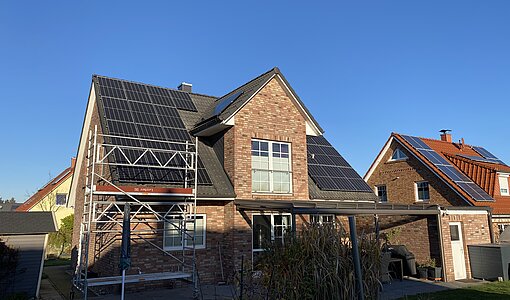"Take buses and trains"!
If you look around on the Internet, there are actually always two main positions when it comes to reducing theCO2 footprint. The first one is to leave your car (or sell it completely) and use public transport.
I find this position somewhat shortened and I am not entirely convinced of it. For sure, public transport is not the holy grail, although it does solve some problems.
To get from A to B quickly in a big city, a functioning public transport system is wonderful. Personally, I find that it works pretty well in Hamburg, for example. The subway arrives within a few minutes and usually covers the distance in a time you can only dream of as a car driver. At the top, at least during the rush hours, one is stuck in a traffic jam. There are also no parking problems with the public transport. But is really everything pink?
No! Of course, there are a lot of people in a subway, a bus or the regional train. But such a vehicle also needs a lot of energy. It becomes absurd when people are softly chauffeured about the fact that cars are quite heavy - yes, that's true: such a regional express is not exactly a lightweight and it really needs a lot of energy to get it moving.
In addition, the railways themselves like to advertise climate-friendly travel, but they only ever back this up with figures from long-distance travel. Even if you ask for it, you can hardly get relevant information for certain commuter routes. The Lübeck-Hamburg line has only been electrified for a few years (but hey: at least it is now!). And: the railways themselves write that they rely on green electricity on long-distance routes; on regional routes this explicitly does not happen.
Deutsche Bahn's current plan is to become completely climate neutral by 2050. To be honest, that doesn't seem particularly ambitious to me. Furthermore, I noticed negatively that only long-distance traffic is being aggressively communicated. The fact that 2/3 of the group's electricity consumption is not used for operating the trains at all is information that the railways are reluctant to put in their advertising - and the figures for the Regional Express are anything but transparent.
I don't want to discourage anybody from going by train; but the only irrefutable truth doesn't seem to me to be that.
"Why don't you move?"
The second simple solution you can find is to move your home to a place near where you work. The idea is simple - and it's too simple. At the moment we live about 5km away from where my wife works and about 62km away from mine. So if we were to move to Hamburg, the problem would only be shifted - and pretty sure we would pay more for a smaller apartment with a worse energy balance. That doesn't seem to me to lead in the right direction.
What criteria are important to me?
But we want to seek solutions, not problems. I consider my place of residence and my workplace to be set, as well as the need to move from one to the other. As I have already written in my introduction, I can imagine project phases that can be managed quite well from the home office. But at least these cannot be planned in advance in the long term and on the other hand they will not reduce my presence in the office to zero.
At the moment I drive a modern Euro6 diesel with an actual consumption of about 5.5 l/100km. Yes, the car also emits NOx, but for the moment I leave that out for theCO2 footprint.
For the evaluation I see mainly four dimensions:
- Thecarbon footprint, which I'm trying to reduce.
- The time I need for my daily working route.
- The costs that are incurred.
- The comfort in terms of the flexibility I have with it.
These dimensions may lead to a conflict of interest. The main focus is on reducingCO2 emissions. But of course the solution has to be practicable (I can't cycle 120km every day to work and back, even if that would be climate-neutral and would also benefit my figure). And of course it has to be affordable somehow.
Comparison of means of transport
I look at my daily commute to work and compare the actual situation (diesel with 5.5l real consumption per 100km) with possible options of public transport and the change to an electric vehicle. The public transport also takes into account that I have to get from home to the train station (bus in city traffic) and in Hamburg from the train station to the nearest subway station. From there it is still a bus station to the office, but I walk to the office and this is not included in the calculation). I have added up the pure travel time; waiting time between connections, delays or cancellation of a connection are not considered.
When considering the CO2 emissions of public transport, I used data from the official sources of the public utilities, the HVV and the railway:
public transport bus in city traffic: 80g/km and person public transport regional traffic: 58g/km and person public transport subway: 0g/km and person (green electricity) car diesel: 146 g/km (real consumption 5,5 l/100km) electric car, German electricity mix: 72.18 g/km (at a rather high 21 kWh/km) Electric car, Stadtwerke Lübeck: 40.14 g/km (at a rather high 21 kWh/km) Electric car Green electricity: 0 g/kWh ( at a rather high 21 kWh/km)
Stadtwerke Lübeck states 223g/kWh asCO2 emissions for the non-eco tariff. The federal average in the electricity mix is 401g/kWh)
| Transportation | Transport time | Transfers | CO2 emissions per year | Costs per year | Comfort & Flexibility |
| car (diesel) | 0.9 h | - | 4.63 t | 2,809.30 € | high |
| public transport | 1.38 h | 2 | 2.06 t | 2,679.96 € | low |
| Electric car (electricity mix Germany) | 0.9 h | - | 2.80 t | 1,949.21 € | high |
| Electric car (electricity mix Stadtwerke Lübeck) | 0.9 h | - | 1.48 t | 1,866.55 € | high |
| Electric car (green electricity) | 0.9 h | - | 0 t | 2,049.38 € | high |
The costs for your own car (diesel or electric) include the running costs including tax and insurance. Not included are acquisition costs or repairs out of series.
The travel time is calculated as described above in more detail in favour of public transport and can quickly add up to 2 hours or more if the situation is unfavourable.
Conclusion
As can be seen from the table, I could reduce my CO2 emissions for the commuting distance by almost half if I switched to public transport. The running costs would be about the same if I were in the office every day. With the car, the costs (and emissions) decrease with each day I am not in the office and do not have to commute - with the train, only the emissions, because the annual ticket must of course be paid for regardless of actual use.
Of course I would have to do without comfort and especially flexibility - since I don't get off at the same time every day, I would have to adjust it more to the timetable. In the worst case, this would quickly add 30 minutes of waiting time for the next regional express from Hamburg to Lübeck and further waiting times for the bus.
This would mean I would spend at least 3 hours a day in public transport; if it goes badly, even up to 4 hours. I do not find this idea very pleasant. The current corona situation does not contribute to make this idea more pleasant for me.
I find the alternative electric car much more attractive. Even if I would fill it with the normal electricity of my electricity provider, theCO2 emission would be lower than with public transport. If the required electricity comes from renewable sources (green electricity), there are no emissions at all. As a bonus, other emissions in city traffic would also be eliminated (NOx in public transport and diesel cars).
Challenge: Climate neutrality.
I want to significantly reduce my CO2 footprint as early as 2021 and become climate neutral in the future. If you want to join me on this adventure and are interested in my progress and thoughts, I will report about it on this page.
If you have any ideas or are facing a similar task, I would be very happy to hear your comment or message.
If you are interested in further contributions to this topic, you can find them here:







Comments (0)
No comments found!